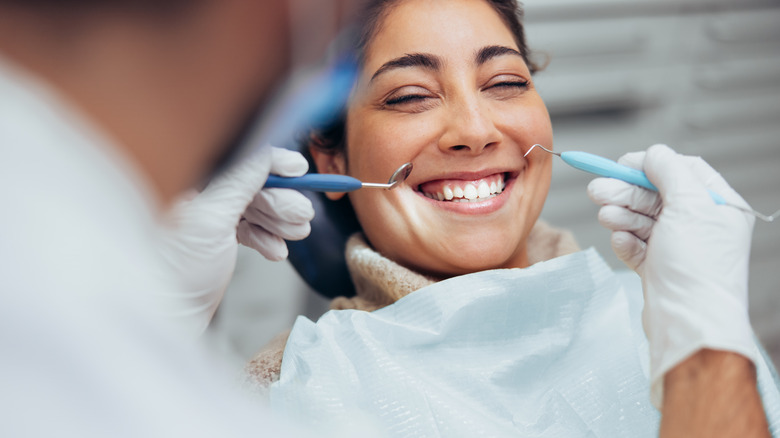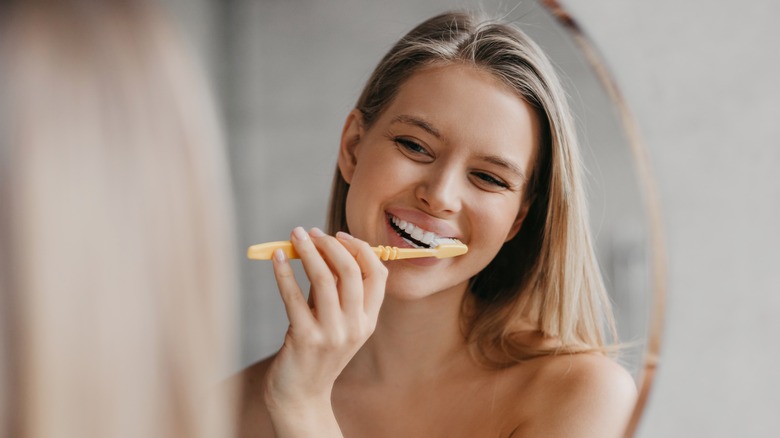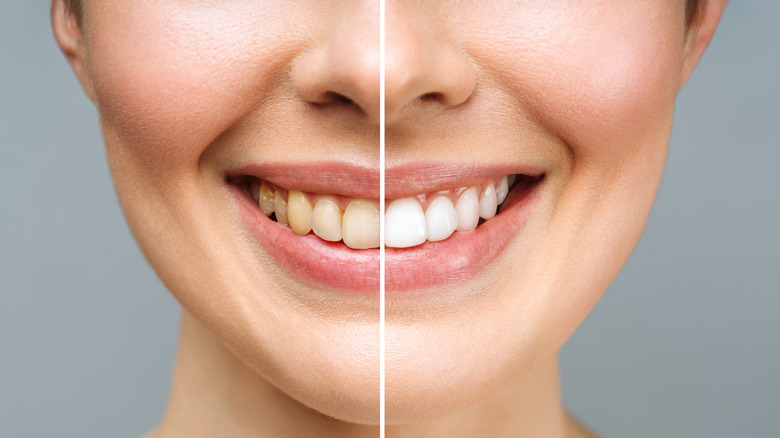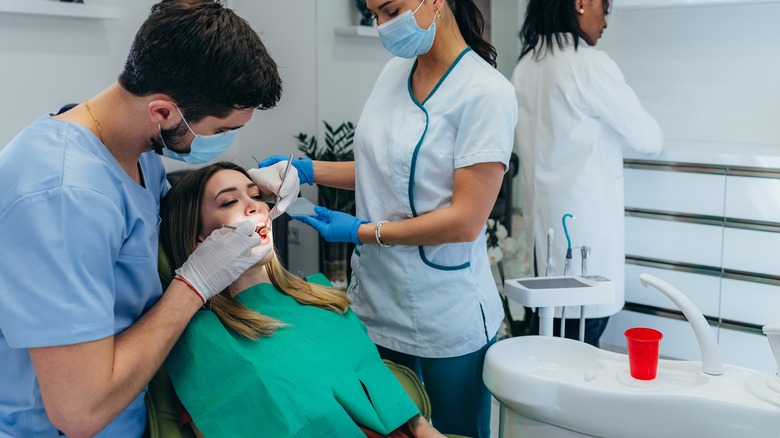The adult mouth has 32 teeth — categorized into four classes: canines, incisors, molars, and premolars, which all have different responsibilities (via Medical News Today). Since you need healthy teeth to perform basic tasks like eating, it’s crucial to prioritize oral health. According to the National Institute on Aging, your teeth and mouth are prone to several health conditions, especially as you age. Unfortunately, around 42% of Americans don’t visit the dentist as often as they would like, even though as many as 85% believe oral health to be crucial to overall health, according to a survey by Delta Dental Institute.
Besides treating existing dental issues, dentists can also help prevent issues that can arise due to poor dental health, including white spots on the teeth. According to Healthline, this unnatural shading of your teeth may signify tooth decay, but can result from various causes. Read on for more details and various tips on how to reduce the appearance of white spots on your teeth.
What causes white spots on teeth?

According to Healthline, white spots can develop if you eat too many acidic foods like lemons or grapefruits, which may eat away the outer layer that protects your teeth from damage. Furthermore, highly sugary foods like fizzy drinks also aid the formation of dental plaque, causing your teeth to develop white spots. The mouth is home to thousands of bacteria. Regularly, this bacteria mixes with food particles and saliva, forming a sticky and translucent film called plaque (via Medical News Today). If not brushed or flossed away in time, plaque can develop into a more permanent coating on the teeth known as tartar, which requires dental assistance to remove.
Dental fluorosis often causes unexplained changes in the appearance of the tooth enamel, usually from fluoride consumed during tooth development, according to the Centers for Disease Control and Prevention (CDC). Most cases are mild and often characterized by scattered white flecks and occasional white spots on the teeth. These spots can appear larger, rough, and more pitted, but this is rare and associated with people who live in areas where water fluoride levels exceed 2 milligrams per liter.
Enamel hypoplasia is another condition that can cause white spots or cause your teeth to become easily stained. According to WebMD, the condition happens when your enamel doesn’t develop properly. The causes are mostly linked to prenatal issues such as maternal vitamin D deficiency, delayed prenatal care, or excessive weight gain during pregnancy.
How to treat white spots on teeth

There are various ways to treat white spots on the teeth, and each might depend on the specific cause. For example, if you have enamel hypoplasia, you might be advised to use CPP-ACP (also known as casein phosphopeptide amorphous calcium phosphate) to prevent the demineralization of your teeth (via WebMD). Your dentist might also recommend minimally invasive procedures like resin infiltration, which involves the direct application of resin to the teeth to lessen the appearance of white spots.
There’s also enamel microabrasion, which uses abrasive materials to rid the enamel of stains and discoloration. Microabrasion helps reduce the appearance of white spots on the teeth by removing certain amounts of enamel (via Medical News Today). Dentists usually follow up the microabrasion process with teeth bleaching, ensuring the teeth appear more even in color, says the source.
According to Healthline, teeth bleaching is another option that lightens the entire tooth, ensuring it matches the color of the white spots. However, the process might not be effective for people who develop this condition from overusing fluoride, as white spots caused by excessive fluoride use may take a different shade of white after bleaching. Alternatively, your dentist might recommend porcelain veneers to conceal the white spots, depending on the severity of your individual case.
Dental hygiene tips to prevent white spots on teeth

Prostock-studio/Shutterstock
Good dental hygiene is a must to prevent discoloration. According to Medical News Today, many people may develop white spots on their teeth before they are 10 years old. Therefore, parents must introduce children to oral hygiene early to reduce the risk of discoloration. Also, parents must supervise teeth brushing for children and ensure they’re using an appropriate amount of toothpaste. Medical News Today advises against using more than a smear of toothpaste for children aged 3 years and under. For children above age 3, the amount of toothpaste should be pea-size. This is all in an effort to prevent excess fluoride exposure.
Other dental health best practices include flossing between the teeth once a day and brushing the teeth with fluoride toothpaste twice daily, as the CDC recommends. Healthline also advises against consuming too much sugary or acidic food to help protect the enamel and prevent white spots. According to the source, expectant mothers who smoke may also subject their children to poor tooth development and related issues like white spots on the teeth.
How to whiten teeth naturally at home

Aleksandr Rybalko/Getty Images
Various natural teeth whitening options exist — some common ones include oil pulling, an age-old Ayurvedic technique where you swish a tablespoon of oil in your mouth for about 20 minutes to pull out bacteria. According to a 2024 article published in the British Dental Journal, the belief is that swirling the oil around your mouth and forcing it through your teeth can help remove toxins, rid the mouth of harmful bacteria, and whiten the teeth. However, the article says there is no scientific evidence to back this up, and notes that oil pulling is in no way an alternative to brushing.
Baking soda is another teeth-whitening technique. As a mild abrasive, it can help scrub away stains, explains WebMD. To apply baking soda to your teeth, you can use a DIY baking soda paste or opt for a toothpaste containing sodium bicarbonate for more sustained teeth whitening effects. Healthline recommends using hydrogen peroxide, a natural bleaching agent that can eradicate bacteria in the mouth when used as a mouthwash. However, it’s best to use a 1.5% or 3% solution to prevent side effects. According to Medical News Today, hydrogen peroxide may not be favorable for long-term use, especially for people with sensitive teeth.
When to see a dentist

Zamrznuti tonovi/Shutterstock
It’s important to visit your dentist as often as possible, especially if you have existing oral health issues. Dental services are even more essential if your lifestyle and dietary choices significantly affect oral health or if you have a family history of oral diseases, says WebMD. You should also consult your dentist before engaging in treatments that carry health risks. For example, some teeth-whitening treatments have short-term and long-term issues. Although effective, healthy teeth are a prerequisite for starting any whitening treatment, says Cleveland Clinic. Underlying cavities and gum diseases may become severe after exposure to bleaching treatments.
Although dentists commonly recommend hydrogen peroxide or carbamide peroxide as effective teeth-whitening remedies, they might not work the same for everyone — it might be weeks before you see results (via Medical News Today). Furthermore, some natural remedies like apple cider vinegar, activated charcoal, and kaolin clay have not been tested for side effects, per Cleveland Clinic. Therefore, such products may require a consultation with your dentist, who can recommend safe practices that offer results.



